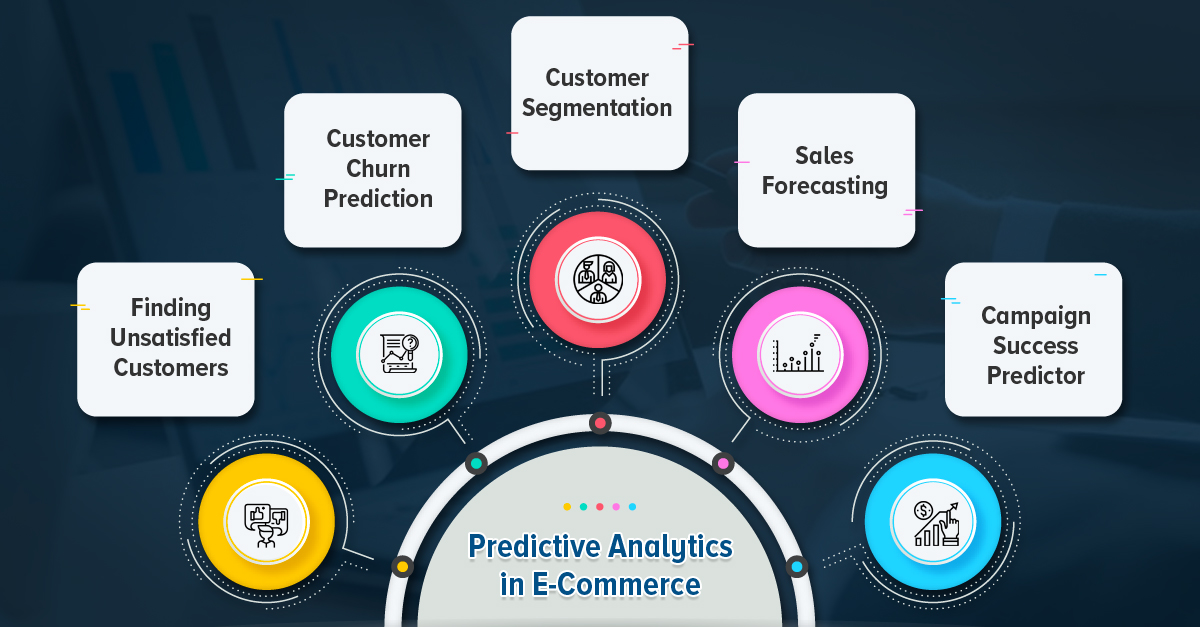12 Ways Predictive Analytics is changing the E-commerce Industry- Part 2

Predictive analytics is the use of algorithms on existing data sets to predict future trends or outcomes. In part 1 of this article, we learned what predictive analytics is and how it is revolutionizing the e-commerce industry by improving conversions of online sales. We also saw various use cases wherein we can apply predictive analytics technology to maximize our sales. Here we are going to discuss some more uses cases in detail.
How is predictive analytics impacting e-commerce?
In addition to the ones discussed in Part 1, below are six uses cases of predictive customer analytics.
- Finding unsatisfied customers
If a customer gives poor feedback in a customer satisfaction survey or calls and yells at a customer support executive with complaints, the business can understand that those customers are at risk of bidding goodbye.
However, not all customers express their disapproval outrightly. Thanks to AI in e-commerce and predictive analytics- you can now figure out unsatisfied customers well in time.
The prediction is made by analyzing the various factors like customer demographics and customer history of all customers. For example, if the predictive analytics engine recognizes an angry customer, it would take into account other factors like frequent calls, long calls, tone of voice during the conversation, and customer history and predict “Customer Satisfaction Score.” These scores can be used by the customer retention team to contact and placate the unsatisfied customer.
- Customer churn prediction
“Customer Churn Score” represents the likelihood of a customer leaving your business. Predictive analytics helps to build a model that can generate a churn score for all customers so that companies can target those customers that are about to leave. Knowing the churn score helps companies to work out better promotions and offers for those customers who are on the verge of leaving.
Customer history data like tenure, total value, last purchase, support calls, returns, ratings and reviews, and Customer demographics like gender, race, age, income are compared to a control population to determine the churn score.
- Finding patterns in customer attrition data
Knowing the churn score is just the starting point. Businesses need to know the reasons behind each attrition case so that when a customer is analyzed with a poor churn score, his cause of likely churn is handy. Predictive analytics experts use the rules-mining algorithm (Apriori Algorithm) that work on the data of customers who quit from the company’s business. The data analyzed may include customer lifetime, customer type, the reason for leaving, age group, employment status, marital status, problems, offers, etc. This predictive analytics model helps to get a broad idea around the rules that lead to customer churn.
- Customer segmentation
Customer segmentation is done to group customers into different segments of the target audience. It helps companies to deal with like-minded customers and to target various marketing campaigns at the correct customer group. Segmentation is usually done on the buying behavior though other factors can also be used for the same. K-means algorithm a popular segmentation algorithm. It divides the datasets into non-overlapping subgroups called clusters based on the analysis of transactional records.
- Sales forecasting
Sales forecasting is the method of predicting future sales by finding trends in the previous sales data. It has helped companies to plan ahead of time. The most common forecasting methods are:
- Lead Value Method
Analyses historical sales data from your leads and use those to create a forecast on the value of each lead
- Opportunity Creation
Based on customer demographics and behavioral data, this algorithm helps to predict which sales opportunities that are likely to close
- Opportunity Stage
This is the most popular forecasting algorithm, and It works by predicting the probability of a sales opportunity to close based on where the customer is currently on the sales process pipeline.
One or more of these forecasting techniques may be used: simple average, moving average, line extrapolation or time series forecasting may be used.
- Campaign success predictor
The goal here is to predict the success score of a marketing campaign. The key input here is the data from previous marketing campaigns. There are a variety of predictive algorithms available and we have to test which provides better accuracy.
Campaign success prediction will help the marketing manager to invest better and develop better marketing campaigns.
Conclusion
We hope this article has delivered you a better picture of predictive analytics and its use cases. If you talk to some predictive analytics consultants, they can provide more examples and implement the above-described applications of predictive analytics in e-commerce. You may contact AISmartz to develop these solutions for your business.
 1-888-661-8967
1-888-661-8967

